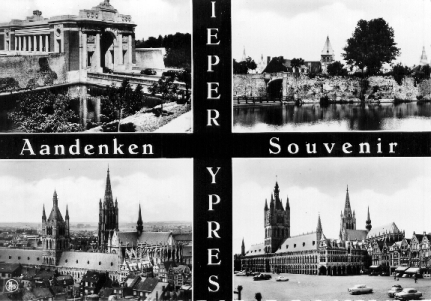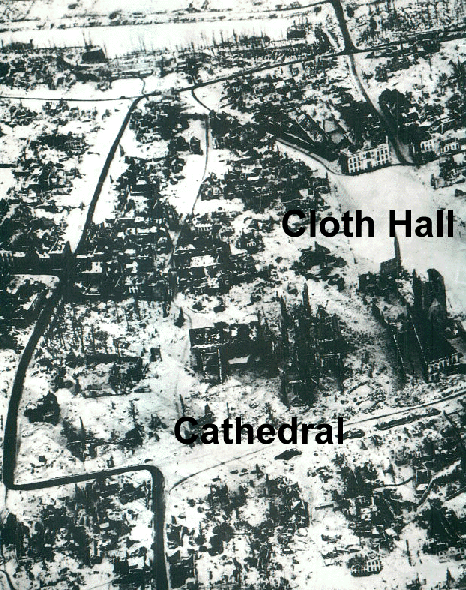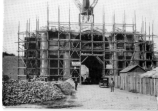

YPRES (Ieper)
Ypres is a pleasant town with an air of old world, however all the ancient building are a sham, everything has been lovingly restored after the complete destruction caused by four year of warfare. During the First Battle of Ypres (Oct-Nov 1914), the Kaiser ordered his troops that they 'Take Ypres or die', and die they did. All but for a short period in Oct 1914, Ypres remained in allied hands, although at a cost. Through out the war Ypres formed a significant Salient up on the Western Front.
The civilians did not leave Ypres until the intense bombardments during the Second

PLACES OF INTEREST
The original Cloth Hall was built over the period 1260-1304, and after suffering severely by German shelling and incendiary devices was rebuilt between 1920 and 1962, and now houses the extensively refurbished (opened spring 1998) Cloth Hall Museum (other museums well worth a visit within the Salient include the Trench Museum at Sanctuary Wood, Hooge Chapel, Hill 60 - the QVR cafe).
The first church was built here in 1073 and the Cathedral in the thirteen century, like the rest of Ypres it was completely destroyed during the war, after the war it was restored to original plans with the exception being that it now boasts a spire, which although included in the original plans, was never built.
Designed by Sir Reginald Blomfield, who also designed many of the cemeteries in the Salient (including Tyne Cot). Its construction was the idea of Field Marshal Lord French (First Earl of Ypres 1921 - who led the original BEF and Commander in Chief until Dec 1915) to accommodate the large number of British still living in and visiting the Salient (However other references quote that the original idea was that of Earl Haig).
The site also included the Eaton Memorial School for the children of the gardeners and official workers in the region. Today the church is a memorial of all those who died in the Salient, with almost every item within dedicated to individuals or regiments.
MENIN GATE
This is the most
important site for the Salient pilgrim (it ranks the most visited
memorial on the Western Front, together with the Beaumont Hamel 
The archway forms the British Memorial to the Missing. The Imperial War Graves Commission (now known as the Commonwealth War Graves Commission) decided that four memorials would be set up to commemorate those who had fallen in the Salient and had no known grave (In fact just after the war the British wished to preserve the town as a memorial to the fallen).
There were about 40,000 unnamed graves in cemeteries in the area and a further 50,000 bodies which has simply disappeared into the Salient mud. It was decided that the New Zealand troops would be included at the Tyne Cot or Messines Ridge and Buttes New Military Cemetery. All other Empire and Dominicans were inscribed on either the memorial at Tyne Cot or Menin Gate.
The Menin Gate was the place for a memorial as many men had passed through the gate on the way to the trenches, a tag line at the time was 'Tell the last man through to bolt the gate'. The bears the names of 54,896 (40,244 UK, 6198 Australian, 6983 Canadian, 564 South African, 6 BWI and 4217 Indian), names of those who died between 1914 and 15th Aug 1917 who have no known grave.
Those lost after this date are listed on the Tyne Cot Memorial. Above the centre arches of the Menin Gate can be found a lion, facing out to the front lines and facing the town a sarcophagus with a flag and wreath. The casements beneath the ramparts were some of the safest places in Ypres during the war and were almost the only thing standing at the armistice. The famous 'Wiper Times' was printed in one of these casements.
Amongst many of the names on the memorial are seven men who won the Victoria Cross in WWI and one other holder of the award. There are also the names of three men who suffered a less glorious death, men who were executed by the British army but whose graves have since been lost.
At the inauguration ceremony in 1927, the buglers of
the Somerset LI sounded the 
Also see The Menin Gate in photo section.
1914 - 1918 War Dead
|
|
Identified
|
Commemorated
on Memorials |
Total
Dead |
Percentage
unidentified or loss |
|
UK & Former Colonies |
447,570 |
440,475 |
888,045 |
50 |
|
Undivided India |
7,789 |
66,543 |
74,332 |
90 |
|
Canada |
54,283 |
19,575 |
73,858 |
27 |
|
Australia |
38,512 |
23,342 |
61,854 |
38 |
|
New Zealand |
11,748 |
6,290 |
18,038 |
35 |
|
South Africa |
6,624 |
2,822 |
9,446 |
30 |
|
Total |
587,526 |
559,318 |
1,146,844 |
49 |